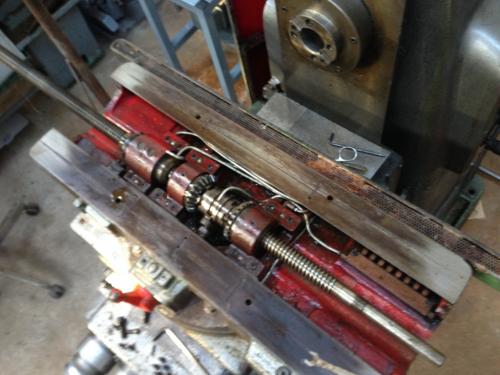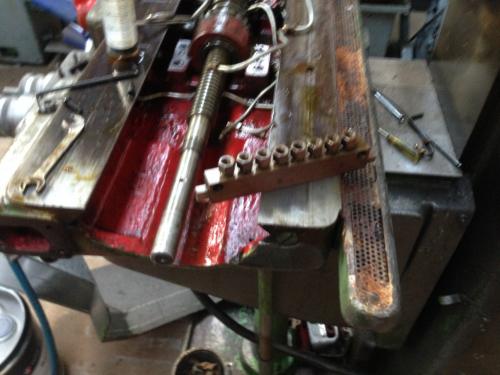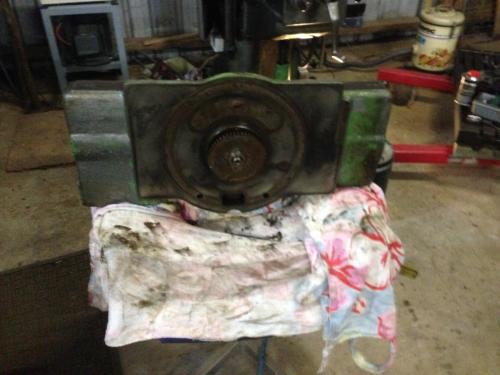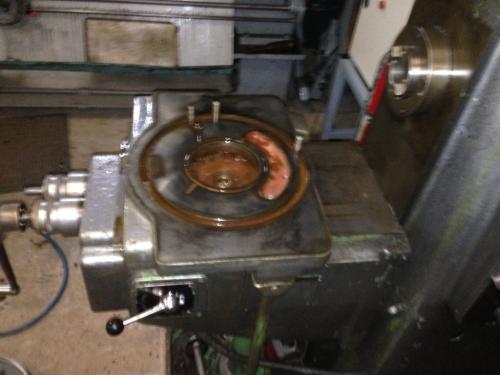Posts: 968
Threads: 67
Joined: Apr 2015
Location: Australia
I was getting close to actually using my new (old) mill now that my phase converter is working, thought I'd better change the oil so I bought a drum of suitable oil. There's a little hand pump under the table with a system of tubes to lubricate the bowels of the machine. So I filled the reservoir and disconnected the feed line to get some oil through the pump...nothing. Took the table off the machine to access the pump.

Pulled the pump apart and it was not only full of crusty gunk but also the piston cups (bit like a brake cylinder) appear to have shrunk and just slop around in the bore, also there's a little ball valve on the inlet side and the spring behind the ball has disintegrated. I picked up some square-section 'o'rings, was going to make a new piston for the pump but then I got called in to work 2 extra shifts so that's on hold til next week.
Got up after a couple of hours sleep this morning and decided to clean out the rest of the oil feed system; took off all the tubes and the manifold and cleaned them through with compressed air the pushed nice clean oil through them with a syringe.

I noticed that the drain system that channels coolant down to the well in the base of the machine lookad a bit gunked up, so i pulled the header part sits behind the table off. 'A bit gunked up' turned out to be very optimistic; it was completely choked the whole way through the passageways, which led to the swivel base under the table coming off.


Cleaned this all out before I ran out of oomph and came in for pizza. My normal working week starts tomorrow so this will have to wait for next days off. I think the next step will be to remove the knee, then I may as well strip it all and give it a fresh coat of paint......
The first oil feed pipe that comes from the pump to the manifold has been kinked and squashed, I spent about 2 hours yesterday afternoon before going to work, driving around trying to source some 5/32 aluminium tubing and olives. Don't want to put it back together as is, even though I can still blow air through it.
Lathe (n); a machine tool used in the production of milling machine components.
Milling Machine (n); a machine tool used in the production of lathe components.
Posts: 44
Threads: 2
Joined: Apr 2013
Location: Nottingham, UK
The following 2 users Like John S.'s post:
EdK (07-31-2015), Hopefuldave (08-22-2015)
I have blocked the drain off in the long gully that runs at the back of the table with car body filler because it either still blocks or just pisses over the floor.
Now got two tapped fittings, one at either end and use two plastic pipes to return it straight into the sump instead of flooding the base. Made it all a lot less messy.
John S., Nottingham, England.
Posts: 968
Threads: 67
Joined: Apr 2015
Location: Australia
Might be a good idea John, the whole drainage system was completely full of a dried, crusty substance. I don't really like the idea of coolant going through passageways that interface at sliding surfaces through the machine, will have a look at how i can redirect it.
Can anyone suggest what industry would use small diameter aluminium tubing with olive compression fittings? I want to replace the squashed piece before reassembling the table. The other day I tried the truck place that I have bought steel air-brake pipe from, I tried the two bearing & industrial suppliers in the town, plus a diesel engine specialist and two plumbing supplies. Nada.
Lathe (n); a machine tool used in the production of milling machine components.
Milling Machine (n); a machine tool used in the production of lathe components.
Posts: 4,683
Threads: 93
Joined: Feb 2012
Location: Perth, Australia
If Enzed and the like cannot help you, you might want to try refrigeration companies...
Hunting American dentists since 2015.
Posts: 691
Threads: 14
Joined: Feb 2015
Location: Oakland, California
I have a Taiwanese mill, and it uses metric soft aluminum tubing in the one-shot lube system. Well.... on disassembly to get it in my shop, some knucklehead (that would be me) crushed some of that tubing. Small quantities are not available in the US, as far as I could tell: I didn't want to buy 50 feet for $100.
McMaster Carr carries fractional inch soft aluminum tube, so I bought some which was close, but not a match. Since I *really* wanted to get the mill up and running again, I spent some quality lathe time and turned my own fittings & "olives" as you call them. All metric threads & diameters on the outside, fractional inch on the inside. Worked a treat and was both faster and cheaper than getting the right diameter tube.
As someone's signature says: if you can't get it, make it.
Posts: 968
Threads: 67
Joined: Apr 2015
Location: Australia
Bit of an update, along with a confession- I abandoned the idea of stripping the machine down completely at this stage, for a couple of reasons- not least of which is that I just needed to get the machine running more than I needed to undertake a major rebuild project. So I decided on a basic cleanup and reassembly.
I took it down as far as the swivel table, cleaned everything out and re-assembled. I also completely dismantled the vertical head attachment, cleaned out all the 1960-era grease and reassembled it, adjusting bearing preload etc and repacking with fresh grease. There is quite a bit to that vertical attachment, must have cost a bomb back in the day.
Along with a new piston for the one-shot lube pump, I used 4mm nylon tubing to replace the crushed section. Direct hand pressure on a 5/8" diameter piston is not going to produce a lot of pressure so I'm sure it will be adequate.
I have actually started to use the machine  , have been milling the two new crossfeed nuts that I threaded ages ago.
Having got the machine running, I'm confronted with a new problem which is that the main 3-phase contactor is bouncing and arcing on startup; I can start the machine in neutral but with a load (i.e. the gear train of the vertical attachment) the contactor will not hold. Whilst I've been milling the two crossfeed nuts for the lathe, the contactor has got worse and worse and now won't hold at all.
I have a few of the more modern contactors left over from the phase converter build, unfortunately the wiring to swap them over exceeds my knowledge of such things. So now I have two almost-finished feed nuts in the machine and look like waiting a week or more for a friend to come and swap the contactor out for me.
Lathe (n); a machine tool used in the production of milling machine components.
Milling Machine (n); a machine tool used in the production of lathe components.
Posts: 8,888
Threads: 320
Joined: Feb 2012
Location: Arizona/Minnesota
You could post pictures of the existing contactor as it's wired in and maybe we can help you with wiring in the new one.
Ed
Posts: 1,827
Threads: 51
Joined: Apr 2012
Location: Oklahoma
sounds like you need a new one, or if they are thick enough to file and clean up the contacts on the one that's in the machine
dallen, proud to be a member of MetalworkingFun Forum since Apr 2012.
If life seems normal, your not going fast enough! 
Posts: 968
Threads: 67
Joined: Apr 2015
Location: Australia
Yeah definitely needs a new contactor, I did dismantle the existing stone-age unit, took the contacts out and gave them a good clean-up with emery paper, made no difference. I have it on good authority that the solenoids get weak, doesn't have the power to hold the contacts together on starting load.
I checked the new contactors that I have and they are all 240v, the machine is 415v so not going to be any use unless I wire a neutral into the phase converter output and the mill and run the switching on 240, just getting more and more complicated, also would need a 5-pin plug which I don't have. I might see the friend who set me on the right path with the phase converter tomorrow, will see if he happens to have any 415v units. If so, will post here for some guidance on installing.
I did manage to run the machine this afternoon enough to convert one of my crossfeed nuts into a paper weight. My first ever milling project was to ruin my first ever internal acme threading project! Thankfully I threaded two blanks while I had the lathe set up so I still have one more to ruin.
Lathe (n); a machine tool used in the production of milling machine components.
Milling Machine (n); a machine tool used in the production of lathe components.
Posts: 1,827
Threads: 51
Joined: Apr 2012
Location: Oklahoma
08-22-2015, 09:03 AM
(This post was last modified: 08-22-2015, 09:04 AM by dallen.)
see if you can get a 415 volt coil for the 240 volt unit, if it has three contacts in it that's all you need to do is swap out the coils.
shame that you trashed the nut, least ways now you know not to do whatever it was that caused the part to be trash, I make a lot of parts two or three times before I find the right one I need
dallen, proud to be a member of MetalworkingFun Forum since Apr 2012.
If life seems normal, your not going fast enough! 
|









 , have been milling the two new crossfeed nuts that I threaded ages ago.
, have been milling the two new crossfeed nuts that I threaded ages ago.